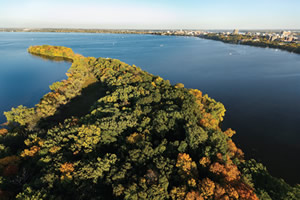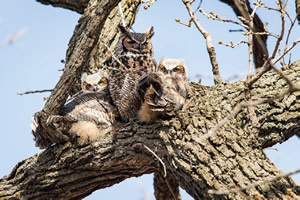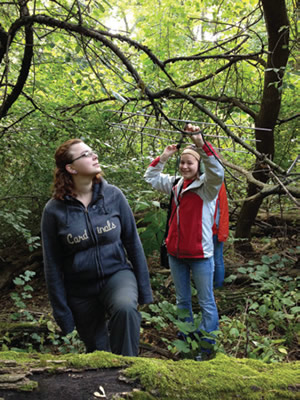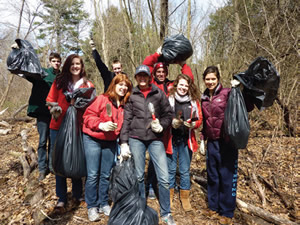Common Ground
- By Alfonso Morales, Gary Brown, Daniel Aragon
- 01/01/16

PHOTO © JEFF MILLER 2013
Here at the University of Wisconsin-Madison (UW), the pursuit of campus sustainability and environmental stewardship has deep roots. In 1935 professor and conservationist Aldo Leopold led the implementation of the world’s first prairie restoration at the UW Arboretum, and its subsequent management married the repair of the ecological communities to the research and education mission of the university. Fast forward to today, and our campus is home to more than 10 LEED-certified buildings, one of the cleanest co-generation power plants in the Midwest and the fewest campus parking spaces of any Big Ten institution — to highlight just a few modern accomplishments. The academic efforts to integrate sustainability at the curriculum and research levels are equally notable. More than 150 courses are identified as having sustainability content, and many of these are in the Lakeshore Nature Preserve (the Preserve, or LNP), a place Leopold would have celebrated.
The Preserve (http://lakeshorepreserve.wisc.edu) is dedicated to conservation and science. Over the last decade both have been strategically employed as part of the educational mission of the university. All the while, these research and educational functions have been facilitated by complex but invisible operations/service functions of the campus-wide Office of Facilities, Planning and Management (FPM), as well as the support of governance models representative of the university and other stakeholders. This example makes clear a pervasive problem of campuses of colleges and universities around the country: the dominant organizational model separates functionally of discrete elements without consideration for how integration of such elements would benefit the educational and research missions of the campus.

PHOTO © JEFF MILLER
SAFE AT HOME. The University of Wisconsin-Madison Lakeshore Nature Preserve shelters biologically significant plant and animal communities for teaching, research and outreach, including this pair of owlets and adult great horned owl.
Learning to Work Together
The UW (like most schools) permits some overlap in functions, as in the case of research and education coexisting at the LNP. This ad hoc approach does bear fruit. However, it fails to focus the substantial resources of the campus in a cohesive approach that optimizes educational and research opportunities. Today, our challenge is overcoming this archaic and inefficient organizational form by effectively integrating efforts across the numerous divisions of campus FPM and the various academic units of campus to directly benefit student education. After all, the core purpose of the university is to “transmit the knowledge, wisdom, and values that will ensure the survival of this and future generations.”
Facilities Planning and Management Leadership at the UW has sought a more seamless incorporation of FPM and academic (research and teaching) activities. Our group inventoried such partnerships between FPM and academic units, identifying activities that bridged functional boundaries and concentrated campus resources on the education of tomorrow’s leaders. This article demonstrates the particular partnership between the FPM’s Campus Planning and Landscape Architecture Department and the LNP, exemplifying an integrative approach to pursuing FPM management goals while enriching the educational and research mission of the university.
The Lakeshore Nature Preserve as a Campus ‘Facility’
Campuses everywhere host multiple land uses, the most iconic of which are typically the “Old Main” type building, a stadium or some exquisite overlook. Typically these facilities are managed to one function, classroom space, etc. Rarely does the greater campus community give thought to the maintenance of those spaces, and how the campus organizations responsible for such might be made more firmly part of the campus educational mission. However, for this new integrative model to take hold a number of relatively independent activities and processes had to be recognized, brought into relationship, and established as interdependent and unitary functions complementary to other important campus goals.
In the example of the LNP, over the course of a century the UW campus acquired and was gifted tracts of lakeshore land that, by 1990, totaled 300 acres. This contiguous, undeveloped natural area was initially conserved and protected for its multiple biomes, but its proximity to campus and community predestined its use for education, research and recreation.

PHOTO © JPROFESSOR JONATHAN PAULI
BE VERY, VERY QUIET. Both through formal classroom activities and leisure activities, the LNP has played a central role in student life for most UW-Madison students. Here, students are collecting squirrel telemetry in the LNP for a Wildlife Techniques course.
For instance, the Biocore program is a four-semester honors sequence that prepares students for a diversity of fields in the biological sciences. The Biocore was among recent campus activities that revitalized educational and research activities in what would become the LNP. Biocore’s initial effort was to re-establish a tallgrass prairie in an abandoned agricultural field at the center of the Preserve. Though piecemeal, such examples helped identify the variety of uses and interests that would be incorporated in the LNP. These parcels were formally unified and named the Lakeshore Nature Preserve in 2004.
At the founding, discussion and documents emphasized various interests and nascent uses determining to advance the Preserve’s contributions to “placemaking,” and to promoting an ethic of stewardship in the faculty, students and surrounding community. In 2011, the Campus Planning and Landscape Architecture Department (CPLA), one of six divisions within the UW FPM, was tasked with managing the Preserve as part of its mission supporting the UW as a preeminent environmental research university.
The staff of CPLA and the Preserve crafted a model of partnership with the greater campus community that builds on three key characteristics.
Forming a Partnership
First and foremost is the long-range commitment to support the academic utilization of the Preserve’s ecological, cultural and land resources. The land acreage and contiguous undeveloped lakeshore is the largest on Lake Mendota and hosts a diversity of ecosystems including tallgrass prairie, broadleaf forests and a variety of wetlands. These biological resources are regularly employed by over 25 different academic departments to help ground student learning in this campus environment. Nearly 20 years on, the Biocore prairie is maturing into a diverse ecosystem that remains a resource for research and education, providing students the responsibility of developing original research plans, collecting data and implementing a series of restoration methods. FPMCPLA has benefitted the Preserve by nearly two decades of planning, implementation and maintenance that directly contributes to the goals of the campus and Preserve’s master plans. Likewise, students learn while they improve an ecological asset, demonstrating a form of place-based learning, which research suggests increases students’ motivation and level of engagement.
The second key to CPLA’s success in integrating campus sustainability and academics is the cultivation of value-added partnerships. While the work of facilities managers holds great potential to improve the educational outcomes of curriculum, we know that the day-to-day management of campus assets will remain the UW FPM’s first priority. The most successful partnerships are those that create direct value for the time investments of both academic and facilities staff.
Research of the Preserve’s biological communities has been going on for well over 100 years and together constitutes a varied, multidisciplinary chronology of change. Data collection has identified artifacts of the ancient cultures that inhabited the Preserve, including habitation sites and effigy mounds. The physical attributes of the Preserve are further classified in hydrologic, soils, topographic and historical surveys.
CPLA staff, faculty from the Departments of History and Geography and members of the UW Cartography Lab collaborated to design and build an interactive, web-based map to collect and share this information. The project now serves as a clearinghouse of information and is utilized by classes visiting The Preserve. The website was recognized by the Association of American Geographers as the “2007 Best Website.” From the perspective of the CPLA, this collaboration reinforces the goal of fostering a community of knowledge sharing without consuming valuable staff hours. Value-added partnerships such as this should be a goal of many facilities-academic partnerships.
The third element to CPLA’s partnership model is to expand the opportunity to engage campus sustainability by balancing contrasting perspectives and sustainability objectives. In the case of the Lakeshore Nature Preserve, there are many expressions of sustainable land use that exist side by side. The conservation of ecological resources is a founding principle of the Preserve. Where many historic farms once existed there are now diverse temperate hardwood forests. The class of 1918 Marsh is of one the earliest wetland restoration projects. CPLA staff continues to work tirelessly to remove invasive species and enhance native plant communities.
One benefit of these conservation efforts is the diversity of flora and fauna that can be observed and studied all year by academic classes. The Preserve also is home to cultivated landscapes. The Eagle Heights Community Garden is one of the country’s oldest community gardens, having been established in 1963. More then 1,000 gardeners using organic techniques care for over 500 plots. The F.H. King Student Farm and agricultural research plots are clustered around the garden, adding further opportunities for student-led agriculture and research opportunities for classes from the College of Agriculture and Life Science.

PHOTO © BRYN SCRIVER
LET’S TAKE CARE OF THIS. Stewardship takes many forms in the LNP, including the removal of invasive plants. Here, UWMadison homecoming committee members volunteer to pull invasive garlic mustard in the Preserve.
Maintaining Public Access
Of equal importance to the ecosystems and agricultural assets of the Preserve is the opportunity for public access to the Preserve. Miles of walking trails have been responsibly planned, built and maintained. A series of fire rings have been constructed on Picnic Point to allow groups of people to have outdoor gatherings. The Lakeshore Path that connects the main UW campus area to the Preserve is constantly in use by walkers, runners and bicyclists.
Maintaining the spirit of environmental conservation and cultural resource stewardship while responsibly incorporating modern expressions of sustainable land use has won the Preserve and CPLA many allies. Proof of this is seen in the 15,000 hours of volunteer service that were catalogued from 2010-2014. The exquisite balance of interests that management has attained at the Preserve has served to expand its value to a broad diversity of campus curriculums. As well, the diversity of the Preserve enhances an overall sense of place and ethic of land stewardship in the campus community.
Lessons Learned
Our view is that campus facilities can have a more integrated role in education and research, and the CPLA/LNP example makes that case. However, and even more important, we have reviewed the UW– Madison leadership in campus sustainability efforts that integrate campus facilities with sustainability curriculum. This concept of the “living-learning laboratory” is not new at Madison, and elsewhere as well there are such partnerships that are providing positive educational outcomes at higher education institutions. What is new in this case is the significant effort made by facilities managers to advance educational and research missions through context specific, partnership processes. We have shown that here at the UW–Madison, the Campus Planning and Landscape Architecture Department’s management of the Lakeshore Nature Preserve furthers the value of campus operations to benefit the learning outcomes of campus academics. In short, other campuses can benefit from this example of developing facilities-academic partnerships that emphasize long-range commitment, add value to facilities and academic missions, and balance a variety of campus and community perspectives.
Many questions remain about how to successfully integrate divisions of the university that have historically been separate. Finding ways to share the valuable work of facilities managers with the campus community takes the ability to see beyond stereotypic interpretations of each other’s missions. Further, potential partners from facilities and academics need to consider the extra burden that such initiatives may place on already tight schedules and resources.
This case shows how web utilities may help in sharing data and information in a manner that is time efficient for faculty, staff and students. It is also important that the efforts of facilities staff are met in return with benefit from the academic community. Reaching this goal requires finding the common ground between the domain expertise and needs of higher education institutions and the domain expertise and needs of the facilities managers that make those institutions live.
This article originally appeared in the issue of .